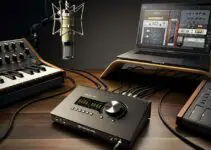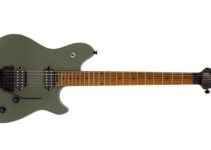The clarinet will always remain a very important solo and accompanying instrument. Often used in genres and styles like orchestral, jazz, blues, and pop, the clarinet remains one of the most outstanding and versatile woodwind instruments you will ever come across.
Just like the clarinet, the piccolo is often orchestrated to double instruments like the violin or the flute. It adds sparkle and brilliance to the overall tonal character of whatever musical scenario or setting it finds itself.
Just like the name suggests, the piccolo clarinet is one instrument with intrinsic characteristics of both the piccolo and the clarinet. With this little but amazing woodwind instrument, you have the best of both the clarinet and the piccolo in one instrument.
The A-flat Piccolo clarinet is a member of the clarinet family. The Piccolo clarinet is smaller than and sounds a perfect fourth higher than the E-flat clarinet.
It is also a minor seventh higher than the B-flat clarinet. Being a transposing instrument, it sounds a minor sixth higher than what is actually written on the score. On that note, its lowest note, E, sounds like a concert middle C.
Although a lot of early twentieth-century composers, use the term “piccolo clarinet” to refer to the E-flat and D clarinets respectively, such classification is not very common today. Instead, the E-flat and D clarinets are more usually referred to as soprano clarinets.
The term “Piccolo” means “small” in Italian, thus, Piccolo clarinet simply means small clarinet. However, the term “piccolo clarinet” is mostly used by some recent music software (e.g., MuseScore and Finale) for the A♭ clarinet.
On that note, for the sake of this article, when we say “Piccolo clarinet,” we are simply referring to the A♭clarinet. In this article, we will discuss everything you will ever need to know about the piccolo clarinet. All you have to do is read on!
Table of Contents
History of the Piccolo Clarinet
The Piccolo clarinet is not a common instrument, but it’s definitely an interesting one. It’s not clear who or when the piccolo clarinet was invented but it can be traced back to the late 18th century in Spain and Italy.
The introduction was because of the desire for a higher-pitched instrument. It incorporated significant improvements to the sax instrument, including adding extra keys, improved intonation, and a more efficient bore design.
With the enhancements in the keys, there was better control and accuracy in playing the higher range of the clarinet.
The piccolo clarinet quickly gained popularity, particularly in wind bands in Spain and Italy, where its bright and piercing sound made it ideal for projecting over other instruments.
Thanks to its compact size, the Piccolo clarinet is a portable choice for musicians on the move. The instrument’s range typically spans from E below the staff to G three octaves above, providing a distinctive and expressive voice in the ensemble.
All through the 19th and 20th centuries, composers and arrangers recognized the unique qualities of the piccolo clarinet and started to feature it in various musical compositions.
Some notable composers, including the Piccolo clarinet in their works, include Verdi, Hans-Joachim Hespos, and Gustav Holst.
In their orchestral compositions, these composers composed solos and ensemble passages, particularly for the piccolo clarinet.
Basics of the Piccolo Clarinet
The Piccolo clarinet, also known as the Ab clarinet, has some distinct features and specifications. The Piccolo clarinet is a considerably smaller size than the standard Bb clarinet and it is typically around 14 inches in length.
The compact size allows for its higher pitch and facilitates easier handling. Like other clarinets, the Piccolo clarinet uses a single reed to produce sound. The reed is a thin cane piece attached to the mouthpiece, and it vibrates when air is blown against it, creating sound.
The Piccolo clarinet uses a smaller and thinner reed, unlike larger clarinets, like the B♭ or bass clarinet. Like other clarinets, the mouthpiece of the Piccolo clarinet consists of a cylindrical tube with a reed attached.
It is made of hard rubber or plastic and has a facing, which is the curved part that contacts the reed. The sound of the Piccolo clarinet depends on the player’s embouchure or how they shape their lips and blow air.
The Piccolo clarinet has a similar key system and mechanics to other clarinets featuring a complex arrangement of keys and tone holes that the player covers and uncovers to control the pitch and produce different notes.
The Piccolo clarinet has a simpler key system when compared to larger clarinets since it doesn’t have certain keys like the register key or some alternate fingerings.
It has a distinctive timbre characterized by its bright and penetrating sound. It is known for its ability to project over other instruments and agility in playing fast and virtuosic passages.
The playing technique of the Piccolo clarinet is similar to that of other clarinets. Players use their fingers to cover and release the tone holes to produce different pitches.
The embouchure and air support play a crucial role in controlling the tone and dynamics of the instrument. The Piccolo clarinet is a compact and higher-pitched member of the clarinet family.
Due to its smaller size, unique sound, and agility, the Piccolo clarinet is versatile in various musical settings, from orchestras and concert bands to chamber music and jazz ensembles.
The Range of the Piccolo Clarinet
The Piccolo clarinet, also known as the Ab clarinet, has a range that extends from E below the staff to the G approximately three octaves above.
As much as the piccolo clarinet’s range and playing characteristics can vary slightly depending on the instrument’s design, the player’s skill level, and personal technique, its range overlaps with the upper register of the standard Bb clarinet.
However, it possesses a distinct shrill sound and character due to its smaller size and higher pitch. The lowest note on the Piccolo clarinet is typically written as E at the button of the staff, which sounds like concert pitch C.
You can ascend through the chromatic scale, playing notes such as F, G, A♭, B♭, etc. The range of the instrument goes up to approximately 3 octaves above the middle C.
The Piccolo clarinet can produce bright, piercing, and resonant tones in the upper register. It possesses a particular brilliance and clarity, which makes it suitable for playing energetic and virtuosic passages.
The highest notes require precise control and focused embouchure to maintain intonation and produce a strong sound. The piccolo clarinet’s extended upper range makes it well-suited for performing melodies, solos, and technical passages that require agility and precision.
Composers often utilize the instrument’s unique capabilities to add distinctive colour and texture to orchestral and chamber music compositions.
The keys on the piccolo clarinet are arranged along the instrument’s body. The player’s fingers cover and uncover the tone holes to control the pitch and produce different notes.
The keys are typically made of nickel or silver-plated brass. They are operated by pressing them down with the fingertips or using combinations of fingers to cover multiple holes simultaneously.
The key system of the Piccolo clarinet is similar to that of the larger Bb clarinet, although it is generally simpler due to the instrument’s smaller size and fewer keys.
However, they’re much more difficult to handle considering the instrument’s size and especially in the higher register which can lead to tuning problems.
What Genre or Musical Scenario Is the Piccolo Clarinet Commonly Used?
The piccolo clarinet is commonly used in various musical genres and scenarios, and its unique sound and characteristics make it a versatile instrument in different musical settings.
Some of the genres and scenarios where the piccolo clarinet is frequently used include the following:
- Orchestral music
- Concert bands
- Marching bands
- Chamber music
- Jazz
- Solos
The Piccolo clarinet is not often featured in orchestral compositions but it can be found in a number of pieces, particularly for Opera. Composers use its distinct timbre and ability to cut through the orchestra’s sound.
It can be found in classical and contemporary orchestral works, performing solos, ensemble passages, or providing colour and texture to the woodwind section. In concert band settings, the piccolo clarinet is not a prominent member of the clarinet section.
It is mostly used for embellishment to add brightness and projection to the ensemble’s sound and is often used for solo passages or as part of the clarinet choir in chamber-like sections.
Its piercing sound helps it to be heard over other instruments during outdoor performances and parades. It contributes to the overall brass and woodwind blend in marching band arrangements.
The piccolo clarinet is occasionally employed in chamber music ensembles, where its unique tonal qualities can be featured in smaller group settings.
It can be found in woodwind quintets, clarinet choirs, and other chamber music configurations, adding variety and colour to the ensemble’s sound. Although the piccolo clarinet is less common than its B♭ counterpart, it’s occasionally used in jazz music.
It can add a distinct voice and a bright, cutting sound to jazz ensembles, particularly in smaller group settings where its higher register can be more easily heard.
Skilled piccolo clarinettists may showcase the instrument through solo performances as part of recitals or competitions.
The solo repertoire for the piccolo clarinet is not as extensive as that for the B♭ clarinet, but there are notable compositions that highlight its unique qualities.
Popular Manufacturers of the Piccolo Clarinet
Some popular manufacturers of the piccolo clarinet include:
Conclusion
The Piccolo clarinet is an interesting instrument with a rich history. Although it’s not very popular, it’s particularly great for genres like orchestral music, jazz, and solo performances.
The Piccolo clarinet has an impressive range of orchestral music, jazz, and solos. In this article, we’ve gone through everything about the Piccolo clarinet, including its history, basic features, range, and more.


![Fender Super Champ x2 vs. Blues Jr [Tones, Features, Versatality, etc..]](https://performerlife.com/wp-content/uploads/2022/09/fender-super-champ-x2-vs-blues-jr-211x150.jpg)


